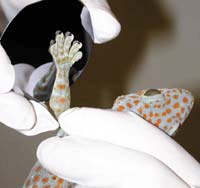Articles and reports from the Life Sciences and chemistry area deal with applied and basic research into modern biology, chemistry and human medicine.
Valuable information can be found on a range of life sciences fields including bacteriology, biochemistry, bionics, bioinformatics, biophysics, biotechnology, genetics, geobotany, human biology, marine biology, microbiology, molecular biology, cellular biology, zoology, bioinorganic chemistry, microchemistry and environmental chemistry.

Forget about duct tape. Just grab the ’gecko glue’
Geckos, nature’s supreme climbers, can race up a polished glass wall at a meter per second and support their entire body weight from a wall with only a single toe. But the gecko’s remarkable climbing ability has remained a mystery since Artistotle first observed it in fourth century B.C.
Now a team of biologists and engineers has cracked the molecular secrets of the gecko’s unsurpassed sticking power–opening the door for e

For nearly 200 years, scientists have known that the elements molybdenum and oxygen can form various large molecules, which usually impart a unique blue color to aqueous solutions. Only recently have scientists been able to isolate these molecules, but no one was able to explain their supramolecular structure in solution, until now. In a paper scheduled to appear in an upcoming issue of the Journal of the American Chemical Society (available online August 20), Tianbo Liu, a physicist at the U.S. Depa

UCI researchers find that consumption of certain food types cause the constricting reptile to expend excessive energy in digestion
Gary Larson, creator of “The Far Side,” is noted for morphing animal scientific attributes into human behavior in his comic strips. Consider the sketch of a family of pythons lying about after Thanksgiving dinner. The snakes that consumed a mouse, some chicken and glucose are ready to go out and play football shortly after dining. But the pythons that indu

A comprehensive examination of how the unique head and snout affects maneuverability and the role of its electrosensory function for seeking food along the ocean floor
Why the peculiar head shape of the hammerhead shark developed as it did has been the subject of much speculation. The dorso-ventrally compressed and laterally expanded pre-branchial head is an unmistakable diagnostic feature of the sphyrnid sharks. This unique head shape has been termed the cephalofoil in recognition of

Researchers at Case Western Reserve University report in the August 22 issue of Nature how magnesium activates microscopic ion channels in the membrane of a cell. These particular ion channels are important in controlling blood pressure. Scientists, the researchers say, can use this new finding in the quest to understand how magnesium helps to decrease blood pressure and also treat heart failure and stroke.
Calcium activated potassium channels are important microscopic pathways in the cell

In this month’s Genome Biology, Mitch Kostich and colleagues from the Schering-Plough Research Institute (NJ, USA) have identified and mapped an important group of molecules known as protein kinases. These molecules are central to the communication of information both within and between cells, in a process known as cell signaling. Defective protein kinases are associated with hundreds of human diseases, including some types of cancer, and it is hoped that this map, which shows the relationships betwe